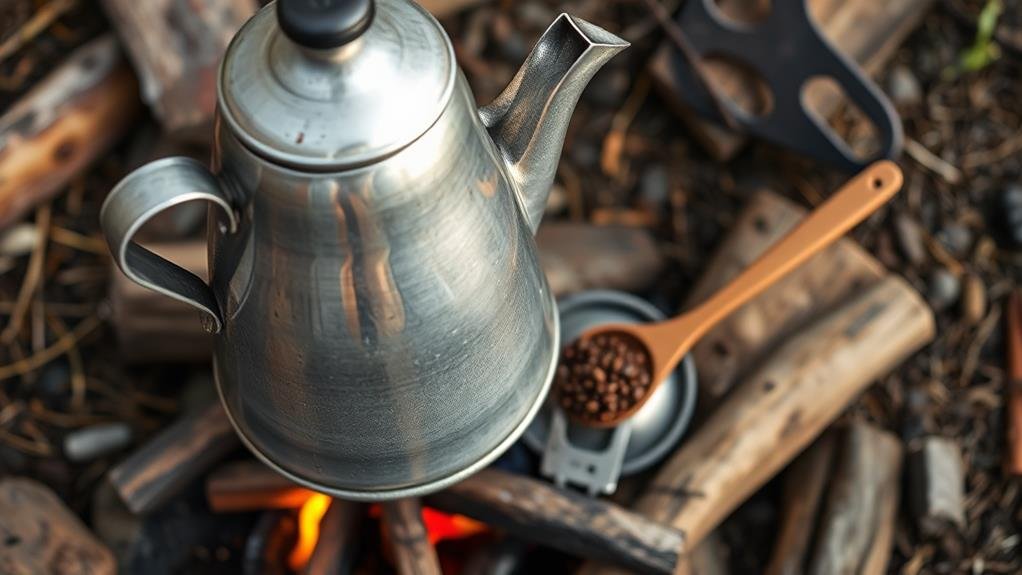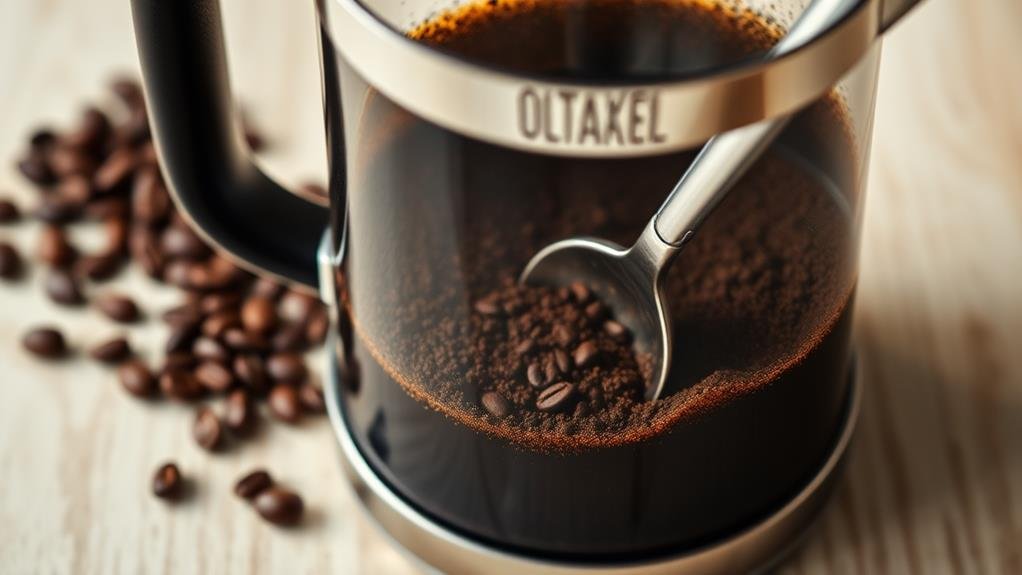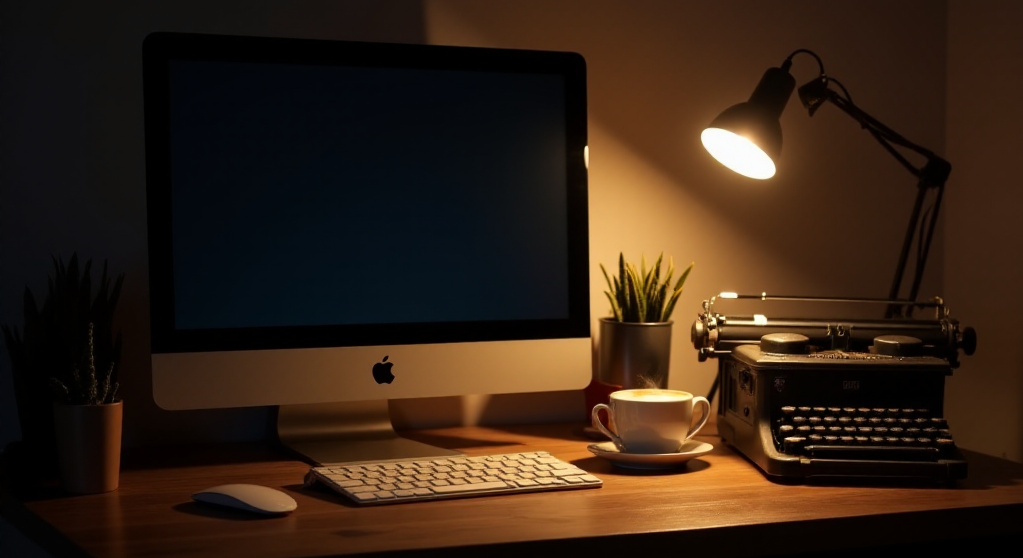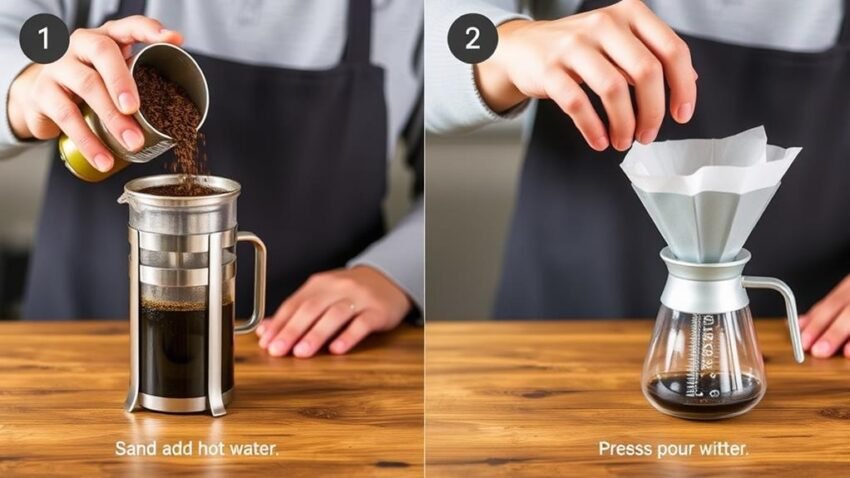As I pour the steaming hot water over the coarse grounds, the aroma of freshly brewed coffee fills the air like a waking dream. Making coffee without filters isn't just about necessity; it's an art that enhances the richness and depth of each sip. Whether you're out on a camping trip or simply prefer a more rustic brew, there are several methods to try. From the cowboy coffee method to the French press, each technique offers a unique experience. But which one will be your new favorite way to start the day? Learn more to discover how you can perfect your filter-free coffee.
Cowboy Coffee Method

To start making cowboy coffee, you'll need a pot or kettle that can handle high temperatures. This traditional method of brewing coffee involves no filters, just boiling water with ground coffee directly in the pot. For the best results, use coarsely ground coffee to prevent the grounds from passing through while pouring.
Start by measuring out your coffee and water. A general rule is to use about one tablespoon of coarsely ground coffee for every six ounces of water. Once you've measured your ingredients, add the coffee grounds to the pot and pour in the water.
Place the pot over an open flame or on a stove and bring the mixture to a boil. Once it's boiling, reduce the heat to let it simmer for a few minutes. The coffee grounds will settle to the bottom of the pot, allowing for a unique and strong flavor.
When you're ready to serve, carefully pour the coffee into your cup, making sure not to disturb the grounds at the bottom of the pot. This method allows you to make coffee without any paper filters, making it ideal for outdoor activities or camping where simplicity and portability are key.
Alternative Brewing Techniques
When looking for alternative brewing techniques that don't require filters, I turn to methods like the French Press and Cowboy Coffee. The French Press offers a full-bodied coffee experience by steeping coarse coffee grounds in hot water, which you then press to separate the grounds from the liquid. In contrast, Cowboy Coffee involves brewing coffee directly in a pot with water and ground coffee, resulting in a rustic but satisfying cup.
French Press Method
Frequently, coffee enthusiasts turn to the French Press method for a rich and full-bodied brewing experience. This technique involves steeping ground coffee in hot water and then pressing the grounds to separate them, resulting in a coffee that is both strong in taste and aroma.
Here are some key points about the French Press method:
- No Filter Needed: French Press coffee is made without using paper filters, allowing all the natural oils and sediment from the ground coffee to be included.
- Customizable Strength: You can adjust the brewing time and coffee-to-water ratio to personalize the strength and flavor of your brew.
- Richer Flavor Profile: French Press brewing typically results in a coffee with more oils and sediment compared to filtered methods, offering a more intense flavor.
To make French Press coffee without a filter, simply combine ground coffee and water in the French Press pot, let it steep for several minutes, and then press down the plunger to separate the grounds. This process guarantees that every drop of your coffee is infused with its full flavor potential, giving you a full-bodied coffee experience. Adjusting brewing time and coffee-to-water ratio allows you to fine-tune your brew to your liking. This method offers a flavorful brew that is distinct from filtered coffees, making it a popular choice among those who prefer strong taste and aroma.
Cowboy Coffee Technique
For those who enjoy a rugged and uncomplicated brewing experience, the Cowboy Coffee Technique is an excellent alternative. This traditional method involves boiling water with ground coffee directly in a pot, eliminating the need for any coffee filter substitute. To make cowboy coffee, start by adding the desired amount of ground coffee per serving to a pot or kettle. Then, pour in hot water, making sure not to overflow the container.
Allow the mixture to boil for a few minutes before reducing the heat and letting it simmer. The coffee grounds will steep in the hot water, resulting in a flavorful cup of coffee. Once you've reached your desired strength, remove the pot from the heat and let it sit for a few moments until the grounds settle to the bottom. This method allows you to enjoy a strong and robust flavor without any filtering process.
When you're ready to serve, carefully pour the coffee into your cup, taking care not to disturb the grounds floating at the bottom. This technique is ideal for outdoor adventures or camping trips due to its simplicity and rustic charm. With cowboy coffee, you can enjoy a rich, unfiltered brew anywhere, anytime.
Filter Substitutes and Options

When making coffee without traditional filters, I've found several creative alternatives that work well. For instance, paper towels, clean dish towels, and reusable tea bags can be used to filter your coffee. Additionally, permanent filter options like gold-plated fine mesh filters offer a sustainable solution.
Creative Filter Alternatives
Creative filter alternatives can transform your coffee-brewing experience, offering both practical and sustainable solutions. If you're looking to move away from traditional coffee filters, here are some innovative options to keep in mind:
- Paper Towels and Dish Towels: These can be used as makeshift filters in a pinch. Simply place a paper towel or clean dish towel in your coffee maker or pour-over.
- Reusable Tea Bags: These fine mesh bags are perfect for brewing coffee and can be washed and reused multiple times.
- Fine Mesh Sieves: A common kitchen tool, fine mesh sieves can effectively strain coffee grounds without the need for disposable filters.
For those seeking more permanent solutions, gold-plated fine mesh filters and cone-shaped permanent filters offer sustainable filtering options. When choosing filter substitutes, it's wise to take into account their environmental impact. For instance, using flour sacks or nitro brew equipment can provide a unique coffee experience while being mindful of sustainability. Additionally, nut milk bags and loose leaf tea strainers can serve as alternative options. Even traditional and nostalgic filter substitutes like coffee milk and buttered biscuits can add a charming twist to your brewing routine. These creative alternatives ensure you can enjoy great coffee while reducing waste and exploring new flavors.
Sustainable Filtering Options
Moving beyond temporary solutions, sustainable filtering options offer a more permanent and eco-friendly way to brew coffee. One of the most effective methods is using reusable metal mesh filters and fine mesh sieves. These options are not only durable but also easy to clean, making them a practical substitute for traditional paper filters.
For those looking for more creative and reusable alternatives, gold-plated fine mesh filters are another excellent choice. These filters provide a precise filtration process without the need for paper. Additionally, cone-shaped paper towels can be reused multiple times before needing replacement, offering a versatile and sustainable option.
Traditional methods can also be sustainable; for instance, letting coffee grounds settle at the bottom of the cup or using a cloth handkerchief as a filter are simple yet efficient techniques. Cloth filters and reusable tea bags also reduce waste significantly by eliminating the need for disposable filters.
Even emergency filters like those made from paper towels, socks, or stocking material can be seen as a step towards sustainability when used in conjunction with more permanent solutions. By adopting these sustainable filtering options, you contribute to reducing environmental impact while enjoying your coffee without the hassle of disposable filters.
Cold Brew Coffee Process
To make cold brew coffee, start by combining coarsely ground coffee and cold water in a large container. This method is perfect for those who enjoy a smoother, less acidic brew compared to traditional hot brewing.
Here's a quick overview of the cold brew coffee process:
- Steeping Time: The coffee grounds steep in cold water for an extended period of 8-12 hours.
- Ratio: Use a 1:6 coffee to water ratio for a strong concentrate.
- Serving: Serve over ice and dilute with water or milk based on your preference.
After adding the coarsely ground coffee and cold water, stir the mixture well and place it in the refrigerator. The steeping process allows the flavors to meld together without extracting the bitter compounds that hot water would. Once the steeping period is complete, filter the coffee using a fine-mesh strainer or cheesecloth to remove the grounds. The resulting cold brew coffee is smooth and less acidic, making it an ideal choice for warm weather or for those who prefer a milder cup of coffee. Enjoy your cold brew by pouring it over ice and adjusting the strength to your liking with water or milk.
French Press and Full Immersion

When it comes to brewing coffee without filters, French press and full immersion methods stand out for their rich, flavorful results. These methods involve steeping ground coffee in hot water, which allows the coffee's natural oils and flavors to fully extract.
French Press Method
In the French press method, you steep ground coffee in hot water for a few minutes before pressing the grounds to the bottom of the container using a plunger. This process results in a robust taste and full-bodied texture that many coffee enthusiasts love.
Full Immersion Method
Full immersion brewing is similar but often more versatile. It involves steeping coffee grounds in water for a specified time before filtering out the grounds. This method allows for a customizable coffee strength and flavor profile, making it ideal for those who like to experiment with different brewing times and coffee-to-water ratios.
| Brewing Method | Steeping Process | Resulting Flavor |
|---|---|---|
| French Press | Steep, then press | Robust, full-bodied |
| Full Immersion | Steep, then filter | Customizable |
| Both | Use ground coffee | Rich, flavorful |
| Both | No need for filters | Enhances natural oils |
| Both | Hot water used | Full extraction |
Both methods offer a rich and flavorful coffee experience without needing traditional filters. Whether you prefer the robust taste of French press or the customizable flavor of full immersion, these brewing techniques are sure to satisfy your coffee cravings.
Serving and Enhancing Coffee
Now that you've mastered brewing coffee without filters using French press and full immersion methods, it's time to focus on serving and enhancing your coffee. This is where you can truly personalize your cup to suit your taste preferences.
To elevate your coffee experience, consider these enhancements:
- Add frothed milk or flavored syrups for a creamy, flavored twist.
- Experiment with alternative milks like almond, oat, or coconut milk for a unique flavor profile.
- Use natural sweeteners such as honey, maple syrup, or agave nectar instead of sugar.
When serving your coffee, you can garnish it with whipped cream, chocolate shavings, or a dash of nutmeg to add both visual appeal and extra flavor. Adjusting the coffee to water ratio allows you to customize the strength and flavor of your brew, ensuring a tailored experience each time. By incorporating these elements, you can transform your standard cup into a gourmet delight that suits your taste buds perfectly. Whether you're looking for something sweet, creamy, or bold, there are countless ways to enhance and enjoy your coffee without filters.
Conclusion
Embarking on the world of unfiltered coffee is a journey, not a destination. With methods like cowboy coffee and French press, you can brew a rich cup that's as bold as your adventures. These techniques let you savor every sip, whether you're camping under the stars or enjoying a quiet morning at home. So why wait? Immerse yourself in the world of unfiltered coffee and taste the difference for yourself. Your palate will thank you, and so will your sense of adventure.

